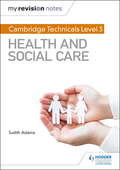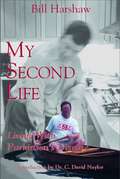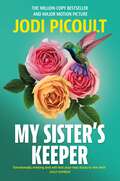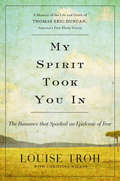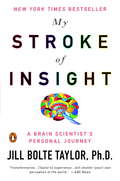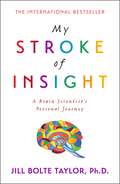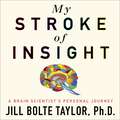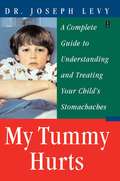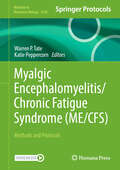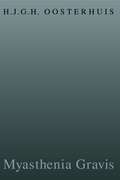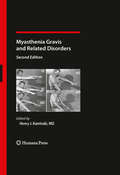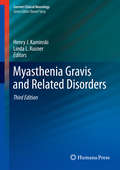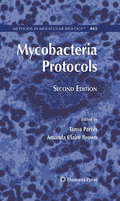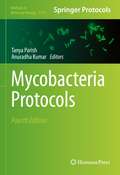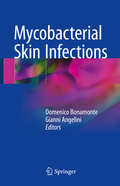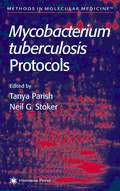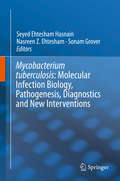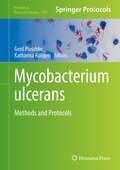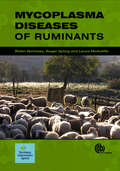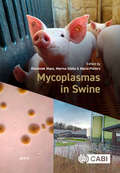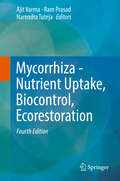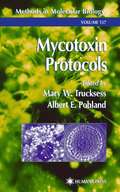- Table View
- List View
My Revision Notes: Cambridge Technicals Level 3 Health And Social Care Epub
by Judith AdamsEnhance your students' practical skills and develop their key content knowledge with this proven formula for effective, structured revision.Target success in OCR's Cambridge Technical Level 3 Health and Social Care with this revision guide that brings together exam-style questions, revision tasks and practical tips to help students to review, strengthen and test their knowledge.With My Revision Notes, every student can:- Enjoy an interactive approach to revision, with clear topic summaries that consolidate knowledge and related activities that put the content into context.- Plan and manage a successful revision programme using the topic-by-topic planner.- Build, practise and enhance exam skills by progressing through revision tasks and Test Yourself activities.- Improve exam technique through exam-style questions and sample answers with commentary from an expert author and teacher.- Get exam ready with answers to the activities available online
My Revision Notes: Cambridge Technicals Level 3 Health and Social Care
by Judith AdamsEnhance your students' practical skills and develop their key content knowledge with this proven formula for effective, structured revision.Target success in OCR's Cambridge Technical Level 3 Health and Social Care with this revision guide that brings together exam-style questions, revision tasks and practical tips to help students to review, strengthen and test their knowledge.With My Revision Notes, every student can:- Enjoy an interactive approach to revision, with clear topic summaries that consolidate knowledge and related activities that put the content into context.- Plan and manage a successful revision programme using the topic-by-topic planner.- Build, practise and enhance exam skills by progressing through revision tasks and Test Yourself activities.- Improve exam technique through exam-style questions and sample answers with commentary from an expert author and teacher.- Get exam ready with answers to the activities available online
My Second Life: Living with Parkinson's Disease
by William A. HarshawAt the age of 37, Bill Harshaw was diagnosed with Parkinson’s Disease. The news changed his life forever,bringing forth a saga that will give hope to not only Parkinsonians, but to people with chronic disease everywhere. My Second Life is not a detailed road map or a set of instructions. Instead, it is an account of his changing state of mind over the two decades that he has had Parkinson’s Disease.Beginning with his diagnosis at the age of 37, this twenty-year journey covers diagnosis, denial, coping with work, early retirement, experimental neurosurgery, and taking a major leadership role in The Parkinson Foundation of Canada. Bill’s account of the two neurosurgical procedures is the first by a patient of the operations that gave him a second chance at life."They say adversity draws out our deepest human qualities. To read Bill Harshaw’s story is to confirm that truth. From the scrap heap of neurogeneration at the same age as Michael J. Fox, to guinea pig for risky brain surgery and then to resurgence and rejoicing, Bill’s exemplary journey is a metaphor for the vast and positive capabilities of the human spirit." -David C. Simmonds, Chair, Parkinson Foundation of Canada
My Sister's Keeper
by Jodi PicoultTHE MILLION-COPY BESTSELLER AND MAJOR MOTION PICTURE'Emotionally riveting and will test your tear ducts to the limit' Daily ExpressIn all thirteen years of Anna's life, her parents have never given her a choice: she was born to be her sister Kate's bone marrow donor and she has always given Kate everything she needs.But when Anna is told Kate needs a new kidney, she begins to question how much she should be prepared to do to save the older sibling she has always been defined by. So Anna makes a decision that will change their family forever - perhaps even fatally for the sister she loves. From internationally bestselling author Jodi Picoult comes a masterpiece which asks us just how much we should do to care for the ones we love. THE BOOK OF TWO WAYS, Jodi's stunning new novel about life, death and missed opportunities is available to pre-order now.
My Spirit Took You In: The Romance that Sparked an Epidemic of Fear: A Memoir of the Life and Death of Thomas Eric Duncan, America's First Ebola Victim
by Christine Wicker Louise TrohLouise Troh--fiancée of Thomas Eric Duncan, the first man ever to die of Ebola in America--breaks her silence about her experience in this deeply moving memoir, chronicling the decade-long love story that starts in Liberia and ends in an isolation ward in Dallas, Texas.
My Stroke of Insight
by Jill Bolte TaylorOn the morning of the 10th December 1996, Jill Bolte Taylor, a thirty-seven-year-old Harvard-trained brain scientist experienced a massive stroke when a blood vessel exploded in the left side of her brain. A neuroanatomist by profession, she observed her own mind completely deteriorate to the point that she lost the ability to walk, talk, read, write, or recall any of her life, all within the space of four hours. As the damaged left side of her brain - the rational, logical, detail and time-oriented side - swung in an out of function, Taylor alternated between two distinct and opposite realities: the euphoric Nirvana of the intuitive and emotional right brain, in which she felt a sense of complete well-being and peace; and the logical left brain, that realized Jill was having a stroke and enabled her to seek help before she was lost completely. In My Stroke of Insight: A Brain Scientist's Personal Journey, Taylor brings to light a new perspective on the brain and its capacity for recovery that she gained through the intimate experience of awakening her own injured mind. The journey to recovery took eight years for Jill to feel completely healed. Using her knowledge of how the brain works, her respect for the cells composing her human form, and an amazing mother, Taylor completely repaired her mind and recalibrated her understanding of the world according to the insight gained from her right brain that December morning.
My Stroke of Insight
by Jill Bolte TaylorThe astonishing international bestseller that chronicles how a brain scientist's own stroke led to enlightenment.On the morning of the 10th December 1996, Jill Bolte Taylor, a thirty-seven-year-old Harvard-trained brain scientist experienced a massive stroke when a blood vessel exploded in the left side of her brain. A neuroanatomist by profession, she observed her own mind completely deteriorate to the point that she lost the ability to walk, talk, read, write, or recall any of her life, all within the space of four hours. As the damaged left side of her brain - the rational, logical, detail and time-oriented side - swung in an out of function, Taylor alternated between two distinct and opposite realities: the euphoric Nirvana of the intuitive and emotional right brain, in which she felt a sense of complete well-being and peace; and the logical left brain, that realized Jill was having a stroke and enabled her to seek help before she was lost completely. In My Stroke of Insight: A Brain Scientist's Personal Journey, Taylor brings to light a new perspective on the brain and its capacity for recovery that she gained through the intimate experience of awakening her own injured mind. The journey to recovery took eight years for Jill to feel completely healed. Using her knowledge of how the brain works, her respect for the cells composing her human form, and an amazing mother, Taylor completely repaired her mind and recalibrated her understanding of the world according to the insight gained from her right brain that December morning.
My Stroke of Insight
by Jill Bolte TaylorThe international bestseller and recommended by medics, patients and the NHS, this is a brain scientist's personal experience of a stroke. It tells of her journey and gives rare insight into human consciousness and its possibilities for all of us.On the morning of the 10th December 1996, Jill Bolte Taylor, a thirty-seven-year-old Harvard-trained brain scientist experienced a massive stroke when a blood vessel exploded in the left side of her brain. A neuroanatomist by profession, she observed her own mind completely deteriorate to the point that she lost the ability to walk, talk, read, write, or recall any of her life, all within the space of four hours. As the damaged left side of her brain - the rational, logical, detail and time-oriented side - swung in an out of function, Taylor alternated between two distinct and opposite realities: the euphoric Nirvana of the intuitive and emotional right brain, in which she felt a sense of complete well-being and peace; and the logical left brain, that realized Jill was having a stroke and enabled her to seek help before she was lost completely. In My Stroke of Insight: A Brain Scientist's Personal Journey, Taylor brings to light a new perspective on the brain and its capacity for recovery that she gained through the intimate experience of awakening her own injured mind. The journey to recovery took eight years for Jill to feel completely healed. Using her knowledge of how the brain works, her respect for the cells composing her human form, and an amazing mother, Taylor completely repaired her mind and recalibrated her understanding of the world according to the insight gained from her right brain that December morning.(P)2008 Penguin Audiobooks
My Stroke of Insight: A Brain Scientist's Personal Journey
by Jill Bolte TaylorThe astonishing New York Times bestseller that chronicles how a brain scientist's own stroke led to enlightenment On December 10, 1996, Jill Bolte Taylor, a thirty-seven- year-old Harvard-trained brain scientist experienced a massive stroke in the left hemisphere of her brain. As she observed her mind deteriorate to the point that she could not walk, talk, read, write, or recall any of her life-all within four hours-Taylor alternated between the euphoria of the intuitive and kinesthetic right brain, in which she felt a sense of complete well-being and peace, and the logical, sequential left brain, which recognized she was having a stroke and enabled her to seek help before she was completely lost. It would take her eight years to fully recover. For Taylor, her stroke was a blessing and a revelation. It taught her that by "stepping to the right" of our left brains, we can uncover feelings of well-being that are often sidelined by "brain chatter." Reaching wide audiences through her talk at the Technology, Entertainment, Design (TED) conference and her appearance on Oprah's online Soul Series, Taylor provides a valuable recovery guide for those touched by brain injury and an inspiring testimony that inner peace is accessible to anyone.
My Stroke of Insight: A Brain Scientist's Personal Journey
by Jill Bolte TaylorThe astonishing New York Times bestseller that chronicles how a brain scientist's own stroke led to enlightenment On December 10, 1996, Jill Bolte Taylor, a thirty-seven- year-old Harvard-trained brain scientist experienced a massive stroke in the left hemisphere of her brain. As she observed her mind deteriorate to the point that she could not walk, talk, read, write, or recall any of her life-all within four hours-Taylor alternated between the euphoria of the intuitive and kinesthetic right brain, in which she felt a sense of complete well-being and peace, and the logical, sequential left brain, which recognized she was having a stroke and enabled her to seek help before she was completely lost. It would take her eight years to fully recover. For Taylor, her stroke was a blessing and a revelation. It taught her that by "stepping to the right" of our left brains, we can uncover feelings of well-being that are often sidelined by "brain chatter." Reaching wide audiences through her talk at the Technology, Entertainment, Design (TED) conference and her appearance on Oprah's online Soul Series, Taylor provides a valuable recovery guide for those touched by brain injury and an inspiring testimony that inner peace is accessible to anyone.
My Tummy Hurts
by Joseph LevyA road map for understanding and managing children's stomach problems -- from symptoms to treatment, and everything in between From baby's colic to an older child's complaint of "my tummy hurts," abdominal distress is painful for kids and worrisome to parents, ranking second only to upper respiratory tract infections as the most common reason for non-routine visits to the pediatrician. In many cases, the discomfort is easily remedied and even prevented -- but some kinds of pain indicate a more serious affliction. How can parents make the distinction? Drawing from more than two decades of experience as a pediatric gastroenterologist, Dr. Joseph Levy offers a prescriptive guide to children's digestive complaints. My Tummy Hurts equips parents with the information they need to help alleviate their children's pain and prevent many disorders from occurring. They'll discover how to ask the right questions, identify problems, recognize the symptoms requiring urgent medical attention, and much more, including: How the digestive system works and why it sometimes malfunctions The major causes of stomachaches Identifying disease triggers, including those related to stress and diet What to do if your child is lactose- or wheat-intolerant My Tummy Hurts, organized for easy reference, is an indispensable handbook for parents and caregivers.
Myalgic Encephalomyelitis/Chronic Fatigue Syndrome: Methods and Protocols (Methods in Molecular Biology #2920)
by Warren P. Tate Katie PeppercornThis detailed volume explores the condition of Myalgic Encephalomyelitis/Chronic Fatigue Syndrome (ME/CFS) and the recent techniques used to investigate the dysfunctional pathophysiology in patients. Beginning with a section on diagnosis, the book continues by covering the chronic cellular and molecular changes in the peripheral immune system that affect their molecular homeostasis, metabolic changes, as well as imaging technologies to understand the brain&’s dysfunction in aberrantly regulating body physiology in ME/CFS. Written for the highly successful Methods in Molecular Biology series, chapters include introductions to their respective topics, lists of the necessary materials and reagents, step-by-step and readily reproducible laboratory protocols, and tips on troubleshooting and avoiding known pitfalls. Authoritative and practical, Myalgic Encephalomyelitis/Chronic Fatigue Syndrome (ME/CFS): Methods and Protocols serves as an ideal guide for clinicians and researchers working to better understand post-viral/stressor conditions in order to improve the lives of those affected with ME/CFS and, most recently, long COVID.
Myasthenia Gravis
by H.J.G.H. OosterhuisMyasthenia Gravis is a neuromuscular disease, caused by an auto-immune process interfering with the acetylcholine receptors at the postsynaptic membrane of the muscle. This book provides guidance on diagnosing the disease, as early diagnosis is important for the application of therapy.
Myasthenia Gravis and Related Disorders
by Henry J. KaminskiAdvances in the study and understanding of myasthenia gravis have led to the need for the publication of this important new edition. The goal of Myasthenia Gravis and Related Disorders, Second Edition is identical to the first -- to provide the clinician and the scientist with a common resource for understanding this complex disorder. This new edition begins with discussions of neuromuscular junction structure and function and follows with updated chapters covering a wide range of topics, such as the acetylcholine receptor, clinical presentation, diagnostic evaluation, and treatment. Importantly, new supplemental chapters have been added; these discuss rigorous clinical assessments of patients for research trials and the epidemiology and genetics of myasthenia gravis. The discussion of the most challenging aspects of myasthenia gravis, its impact on patients' psychological make-up, has been expanded as well. Myasthenia Gravis and Related Disorders, Second Edition retains the "personal approach" of the authors regarding treatment and is a valuable resource for meeting the many and varied needs of patients with myasthenia gravis.
Myasthenia Gravis and Related Disorders: Xith International Conference (Current Clinical Neurology #6)
by Henry J. Kaminski Linda L. KusnerThe third edition of this important, gold-standard title outlines a range of significant advances in the study and understanding of myasthenia gravis. The overarching goal of this new edition is identical to the first and second -- to provide the clinician and the scientist with a common resource for understanding the profound achievements in the clinical, translational, and basic sciences of neuromuscular transmission disorders. In addition to several new authors and an extensive update of all chapters, this third edition includes summaries of pre-clinical research standards for autoimmune MG, along with a broad summary of MG clinical trial performance. The now greater understanding of the clinical presentation of MuSK-related MG and identification of potential new autoantigens, including LRP-4, is discussed. The development of treatment guidelines by groups in Japan, the United Kingdom, Germany, and an international consortium is also outlined. Myasthenia Gravis and Related Disorders, Third Edition, is an invaluable resource for meeting the many and varied needs of clinicians who treat patients with myasthenia gravis.
Mycobacteria Protocols
by Tanya Parish Amanda Claire BrownDue to the rising threat of tuberculosis and other mycobacterial infections, methods to study the biology of the mycobacteria and to improve diagnostic, therapeutic and preventative reagents are still very much in need. Mycobacteria Protocols, Second Edition updates and refines the methods of the well-received first edition while adding newly developed methods culled from the most cutting-edge research in the field. Ranging from the basics of sub-cellular fractionation to advanced methods using specialized growth conditions and whole genome, transcriptome and proteome analysis, the chapters conform to the Methods in Molecular BiologyTM series format, providing step-by-step laboratory protocols, lists of necessary materials and reagents, and tips on troubleshooting and avoiding known pitfalls. Comprehensive and up-to-date, Mycobacteria Protocols, Second Edition is the perfect resource to promote and stimulate further research into these intriguing, important and most fractious of bacteria.
Mycobacteria Protocols (Methods in Molecular Biology #2314)
by Tanya Parish Anuradha KumarThis fully updated edition explores the latest techniques to study the challenging, and at times dangerous, genus of bacteria known as mycobacteria with basic methods that are still required for mycobacteriology along with the newer or improved methods that have been developed. The volume features chapters on the basics of DNA isolation, protein isolation, and lipid isolation, as well as more sophisticated techniques for isolation of ribosomes, and continues with sections involving analyzing subcellular fractions, culture methods, sequencing technology, in vitro models, molecular methods, as well as drug discovery applications. Written for the highly successful Methods in Molecular Biology series, chapters include introductions to their respective topics, lists of the necessary materials and reagents, step-by-step, readily reproducible laboratory protocols, and tips on troubleshooting and avoiding known pitfalls. Authoritative and up-to-date, Mycobacteria Protocols, Fourth Edition serves as an ideal guide for those starting out with their mycobacteria research and also for those who have worked with it for decades.
Mycobacterial Skin Infections
by Domenico Bonamonte Gianni AngeliniThis well-illustrated book is a comprehensive guide to the cutaneous clinical presentations of mycobacterial infections. The Mycobacterium genus includes over 170 species, nontuberculous mycobacteria (NTM) having been added to the obligate human pathogens such as M. tuberculosis and M. leprae. NTM are widely distributed in the environment with high isolation rates worldwide; the skin is a major target with variable clinical manifestations. A current resurgence in tuberculosis is aggravated by the synergy with human immunodeficiency virus, the breakdown of health care systems, and the rise in multidrug-resistant disease, as the incidence of leprosy remains stable, at around 250,000 new cases annually, regardless of effective antibiotic therapy. Presentations of various cutaneous infections caused by mycobacteria may be overlooked by clinicians owing the lack of familiarity with tuberculosis, leprosy, and the related NTM clinical features. This handy guide will help the dermatologist to spot the different clinical manifestations, make a prompt diagnosis, and apply effective treatment.
Mycobacterium Tuberculosis Protocols
by Tanya Parish Neil G. StokerLeading investigators with extensive practical knowledge and experience describe their best methods for studying the tuberculosis pathogen. Packed with step-by-step instructions to ensure successful results, these methods range from basic handling techniques to the application of functional genomics. Highlights include methods for the basic safety and culture of M. tuberculosis, fractionation of the bacterium (nucleic acids, lipids, culture filtrate, and capsule), the analysis of gene expression (start site mapping, real-time PCR microarrays, and proteomics), the growth of the bacterium in macrophages and low oxygen, cytological analysis of the bacteria, and diagnostics. Highly practical and accessible, Mycobacterium tuberculosis Protocols utilizes advanced functional genomics and mutagenesis methodologies to provide both experimental and clinical investigators all the powerful techniques needed to illuminate the molecular biology of tuberculosis and its interactions with host cells, and so drive work on the wide variety of emerging therapeutic opportunities.
Mycobacterium Tuberculosis: Molecular Infection Biology, Pathogenesis, Diagnostics and New Interventions
by Seyed Ehtesham Hasnain Nasreen Z. Ehtesham Sonam GroverThis book reviews recent advances in the molecular and infection biology, pathology, and molecular epidemiology of Mycobacterium tuberculosis, as well as the identification and validation of novel molecular drug targets for the treatment of this mycobacterial disease.Despite being completely curable, tuberculosis is still one of the leading global causes of death. M. tuberculosis, the causative organism – one of the smartest pathogens known – adopts highly intelligent strategies for survival and pathogenesis. Presenting a wealth of information on the molecular infection biology of M. tuberculosis, as well as nontuberculous mycobacteria (NTM), the book provides an overview of the functional role of the PE/PPE group of proteins, which is exclusive to the genus Mycobacteria, of host-pathogen interactions, and virulence. It also explores the pathogenesis of the infection, pathology, epidemiology, and diagnosis of NTM. Finally it discusses current and novel approaches in vaccine development against tuberculosis, including the role of nanotechnology. With state-of-the-art contributions from experts in the respective domains, this book is an informative resource for practitioners as well as medical postgraduate students and researchers.
Mycobacterium ulcerans: Methods and Protocols (Methods in Molecular Biology #2387)
by Gerd Pluschke Katharina RöltgenThis volume explores the latest techniques used to study Mycobacterium ulcerans, and more specifically M. ulcerans disease (Buruli ulcer). The chapters in this book are organized into three parts and cover methods for the detection of M. ulcerans and the analysis of host-pathogen interaction; the quantification and characterization of mycolactone, the macrolide toxin of M. ulcerans; and drug development against M. ulcerans. Written in the highly successful Methods in Molecular Biology series format, chapters include introductions to their respective topics, lists of the necessary materials and reagents, step-by-step, readily reproducible laboratory protocols, and tips on troubleshooting and avoiding known pitfalls. Authoritative and cutting-edge, Mycobacterium ulcerans: Methods and Protocols is a valuable resource that helps scientists advance their research on Buruli ulcer, which is still an under-researched field in infection biology.
Mycoplasma Diseases of Ruminants
by Robin Nicholas Roger Ayling Laura McauliffeMycoplasmas are the smallest of free-living organisms and are intermediate between viruses and bacteria. Many species thrive as parasites in animal (including human) hosts. This book is based on proceedings of a conference held in Palermo, Italy. It reviews some of the most important mycoplasma diseases of sheep, goats and cattle including contagious bovine pleuropneumonia, contagious agalactia and calf pneumonia, which are listed by the OIE because of their economic implications.
Mycoplasmas in Swine
by Dominiek Maes, Marina Sibila & Maria PietersSwine can be infected with many different mycoplasmas. Some are important pathogens, causing significant health and welfare issues in pigs and major losses to the swine industry worldwide. Other mycoplasmas are not pathogenic for swine and can be considered commensals. This book provides up-to-date scientific, clinical and practical information of the most important pathogenic mycoplasmas in swine. Most emphasis has been placed on Mycoplasma hyopneumoniae as the most economically important, but other pathogenic species like Mycoplasma hyorhinis, Mycoplasma hyosynoviae and Mycoplasma suis are also discussed. Written by internationally renowned scientists and clinicians from all over the world, this book draws together in depth knowledge, expertise and experience in swine mycoplasmas to provide an evidence-based, academically rigorous and practical collection. It aims to serve the scientific and veterinary community and the swine industry worldwide.
Mycorrhiza - Nutrient Uptake, Biocontrol, Ecorestoration
by Narendra Tuteja Ajit Varma Ram PrasadThis is the fourth updated and revised edition of a well-received book that emphasises on fungal diversity, plant productivity and sustainability. It contains new chapters written by leading experts in the field. This book is an up-to-date overview of current progress in mycorrhiza and association with plant productivity and environmental sustainability. The result is a must hands-on guide, ideally suited for agri-biotechnology, soil biology, fungal biology including mycorrrhiza and stress management, academia and researchers. The topic of this book is particularly relevant to researchers involved in mycorrhiza, especially to food security, plant microbe interaction and environmental protection. Mycorrhizas are symbioses between fungi and the roots of higher plants. As more than 90% of all known species of plants have the potential to form mycorrhizal associations, the productivity and species composition and the diversity of natural ecosystems are frequently dependent upon the presence and activity of mycorrhizas. The biotechnological application of mycorrhizas is expected to promote the production of food while maintaining ecologically and economically sustainable production systems.
Mycotoxin Protocols
by Mary W. Trucksess Albert E. PohlandA panel of accomplished scientists describe their innovative, cutting-edge methods for determining the levels of mycotoxin contamination in foods and feeds. Almost half the methods presented involve molecular-based immunochemical or immunochemical/chromatographic techniques. The necessary equipment, reagents, and procedures are given in great detail for the analysis of a wide variety of mycotoxins, including aflatoxins, aflatoxin M1, cyclopiazonic acid, ochratoxin A, trichothcenes, moniliformin, fumonisins, zearlenone, Stachybotrys toxins, citrinin, patulin, ergot alkaloids, and Alternaria toxins. General techniques for mycotoxin analysis, sampling procedures for collecting representative test samples, isolation techniques, and techniques for the detection and identification of toxins and impurities are also included. Up-to-date and highly practical, Mycotoxin Protocols provides a comprehensive collection of the latest bioanalytical techniques for evaluating the contamination of mycotoxins in foods and feeds.
